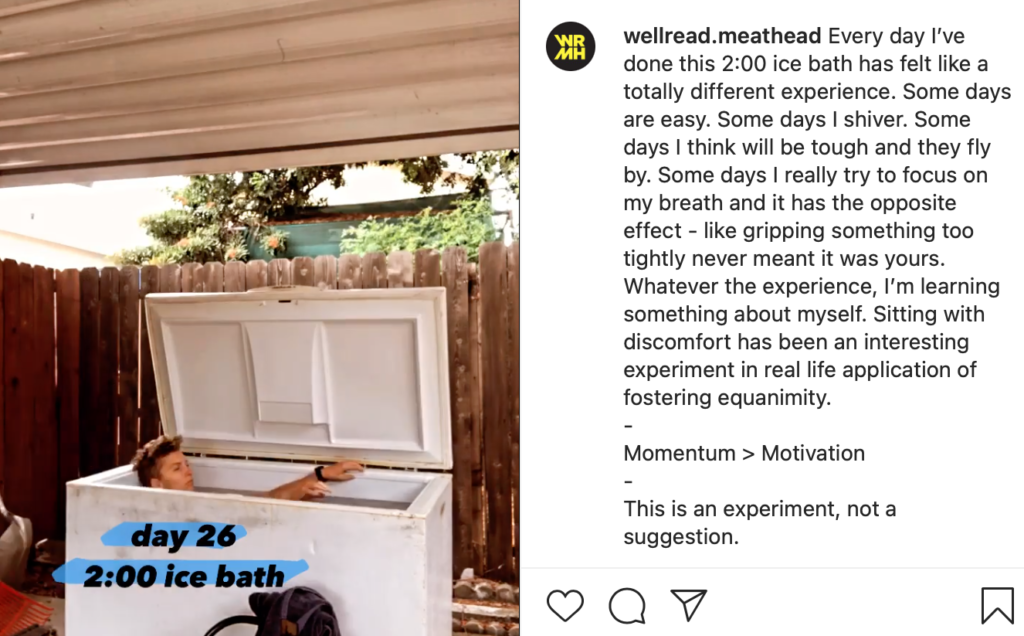
101 Days of Cold: Lessons Learned
Written by Kirsten Ahrendt
I recently finished my 2020 ice bath challenge! Ice-Ice-baby! What?! Huh?! Quick recap for those who have no clue what I’m talking about…on October 1st I began a 90-day habit challenge. I chose to perform a daily ice-bath for each remaining day of 2020.
The Parameters
Take a 2-minute daily ice bath. In the event I could not ice bathe, substitute a 4-minute cold shower. I had recently refurbished an old freezer chest into an ice bath because I’m already convinced of the mental and physical health benefits of cold exposure. So logistics on this wasn’t too tough.
The Intention
My primary intention was rooted in curiosity and exploration into my own patterns of behavior. I wanted to explore:
- What factors of success or failure would I encounter?
- Which could I overcome easily and which did I struggle to reframe?
- What lessons would I learn through the simple act of consistent, daily repetition of a single task – about myself, about the effects of cold exposure, about consistency in general?
The Outcome
I successfully completed 101 days of ice baths/cold showers. At day 73, I emptied the ice bath to fix a few leaks. From that point on I switched to cold showers. You would be sorely mistaken to assume the experiment got easier after that switch (see lesson #4). Below is my recap of the experience.
Lesson 1:
Singular focus > dispersed focus.
Initially, I identified two goals to pursue during my 90-day challenge. 1) daily 2-minute ice bath; and, 2) draw a daily sketch. I failed item #2 within 1 week. 1 FKN WEEK! I swear, I had a genuine desire to express my creativity. It turns out, a “daily doodle” wasn’t the right outlet. Instead of letting my lack of commitment to that endeavor sink my entire ship, I cut it off, before it could infect the success rate (read commitment) to the rest of my challenge. Like a gangrene toe – “bye bye, dead weight!”
I learned that if I want to truly be successful, I need a narrow focus – possibly even singular. With one primary focus, I discovered I was more likely to find a flow state, have greater mental clarity, and less willpower-fatigue towards accomplishing the task.
Deep down, I’ve always known this about myself – my best work and ability to stick to a plan has arisen from extreme focus on a singular objective. I am certain that American society’s “busy as a badge of honor” mentality has deafened me to my own instincts. When we glorify the “always be busy/do more” lifestyle, we often conflate “much work” with “intense work”. One will be more impactful than the other.
Lesson 1 is most definitely a personal lesson not a universal one. A better person could’ve done both. But I’m learning about my own tendencies so that I can work WITH THEM rather than AGAINST them. And I encourage that for you too. Whether reading the lessons below or reading the NYT #1 self-help book, remember that someone else’s lessons/tips may not be the right ones for you.
Lesson 2:
Stress is a mirror.
Let’s be clear – sitting in 38-degree water is a source of stress. That stress will cause a cascade of reactions in your mind and body – some of which you can exert control over, some of which you cannot. Stress (in this case “cold”) is a mirror. If you freak out, the experience will match your freak out. If you remain calm, the experience will match your calm.
I liken it to your nervous system controlling a volume dial. Listening to music with the volume on level 3 is a pleasant experience. Listening to music with the volume dial turned all the way up and your head 2 inches from the speaker is #stressfulAF. When I or others entered the ice bath, those who could remain calm, essentially turned the volume dial of their reaction (and subsequently their experience) down to a pleasant volume – and their experience followed suit.
If instead, I breathed like a dragon and I couldn’t get control of my mind – planning escape routes and silently screaming “Get the f out!” (real talk – I’m talking about my wife here) it was akin to maxing out the volume dial. Your mind and nervous system can control how far away you figuratively stand from that “speaker of stress”.
Lesson 3:
Exhale – the key to chilling the f out.
“While breathing normally, heart rates usually increase during inhalation and decrease during exhalation. This cyclic change in heart rate, that is driven by breathing, is known as Respiratory Sinus Arrhythmia (RSA).”** Additionally, a long slow exhale can drive a parasympathetic response (vs sympathetic/upregulating). Using this information, I consciously focused on lengthening my exhales while in the cold water, as well I coordinated my entrance to the ice bath on an exhale rather than an inhale. The longer and smoother my exhale, the calmer of states I found myself. Causation? Correlation? The lines are blurry. My number one suggestion to anyone entering cold (or a stressful situation) is to lengthen their exhale. **Research Paper
Lesson 4:
Apples to apples or apples to oranges. It all sucks.
Without a doubt, the 2-minute ice baths were easier/more enjoyable than the 4 to 5-minute cold showers. Temperature-wise, the ice bath was colder by far, which would lend you to believe it would be more difficult. But the all-encompassing nature of its intensity made it easier to focus and be in the moment (to even find “flow”). In contrast, the shower was cold…cold enough to make me miserable, but not cold enough to be all encompassing, while being quite long enough to make me wonder “when will this be over”…multiple times. Things are difficult for a variety of reasons (intensity, duration, prior experiences, trauma, etc) – and often not the ones you initially think they will be. So, expose yourself to a variety of challenges, there’s a lesson in each.
Lesson 5:
Motivation comes in waves. It is not to be relied upon.
The first 30-days felt fun, new, easy, exciting. “Look at me, world! I’m strengthening my consistency muscle! Isn’t this fun?!” At the 50 day mark, I lost some enthusiasm. And once I switched to longer cold showers…it was truly one day at a time.
More days than not, I was not motivated to be cold. However, I felt the momentum of all the prior days accumulated. Once I could weigh 4 minutes of discomfort in comparison to 75 days accomplished, the decision was easier. Don’t count on motivation to help you reach any goal – ever. It’s nice to have, but not a necessity. I think this is the number one thing more people should recognize. You’re not broken for being unmotivated – you’re actually normal. Motivation is not the source of action, it’s often the consequence of action!
Lesson 6:
Control variables to increase your chances of success.
I have literally never been a morning person. I used to work out at 9pm and do my artwork at 11pm, so I’m not here to tell you about the early bird, its damn worm, or my 10-tips to win the morning (Coffee. All 10 steps. DUH!). On a number of days, I didn’t make time for my cold plunge and had to do it at 10pm, the latest I ice bathed was 11:57pm. (If you save a task til the last minute, it only takes a minute!).
I quickly realized I could suffer through and still accomplish my 90-day challenge by leaving this task to the end of the day, but that it would extract a larger mental and emotional toll. So, I arranged my morning routine around it. It felt good to get it crossed off my to-do list, and it freed up vital brainpower and willpower for other decisions in the day. None of this is rocket science; I’m pretty sure every parent reading this who comes to the 6am class is going to punch me in the face and say “No crap, Einstein!”. But the larger lesson is that if you identify something you want, you have to put a structure in place to support your path to achieving it. We can fail going after a goal for many reasons – but don’t let it because you made it harder than it had to be. Control the controllables.
For more on mindset, read: The Invictus Mindset: An Athlete’s Guide to Mental Toughness
